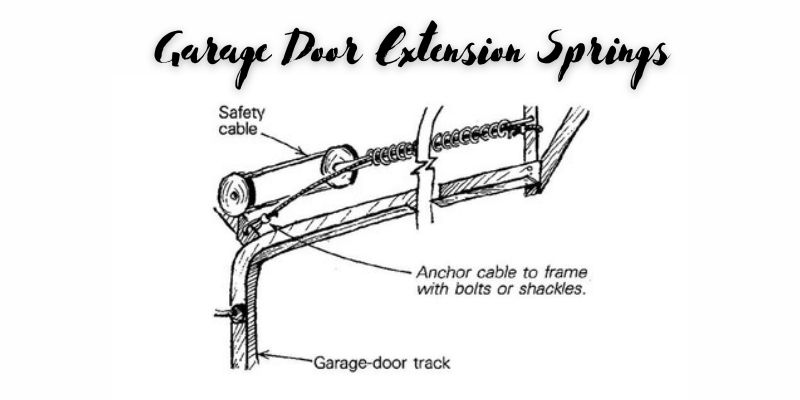Garage door extension springs play a crucial role in the functionality of your garage door, providing the necessary counterbalance to facilitate smooth opening and closing. Understanding these springs, their function and proper maintenance is essential for homeowners looking to ensure the longevity and efficiency of their garage doors.
Anatomy of Garage Door Extension Springs
1. Basic Structure:
- Extension springs are typically installed in pairs, running parallel to the horizontal tracks on both sides of the garage door.
- They stretch and contract to support the door’s weight during operation.
2. Safety Cables:
- Many extension spring setups include safety cables. These cables run through the extension springs to contain them in case of breakage, preventing potential injuries or property damage.
Functionality and Operation
Understanding how garage door extension springs function is vital for homeowners:
1. Counterbalance Mechanism:
- Extension springs counterbalance the weight of the garage door, making it easier to lift manually or by the garage door opener.
- The correct tension ensures the door opens and closes smoothly.
2. Extension and Contraction:
- When the door is closed, extension springs are in a stretched position.
- As the door opens, the springs contract, storing energy for the next closing cycle.
Signs of Extension Spring Issues
Detecting problems with extension springs early is crucial to prevent further damage:
1. Uneven Movement:
If one side of the door moves faster than the other, it may indicate an issue with the extension springs.
2. Visible Wear or Damage:
- Inspect the springs regularly for signs of wear, rust, or damage.
- If you notice any issues, it’s advisable to seek professional assistance promptly.
Garage Door Extension Spring Maintenance Tips
Regular maintenance can significantly extend the lifespan of your extension springs:
1. Visual Inspections:
- Regularly visually inspect the extension springs for any signs of wear, rust, or damage.
- Pay attention to safety cables for fraying or slack.
2. Lubrication:
- Apply a silicone-based or white lithium grease lubricant to the extension springs.
- Ensure even distribution to prevent friction and corrosion.
3. Professional Tune-ups:
- Schedule professional garage door tune-ups annually to address any potential issues before they escalate.
- Professionals can identify and replace worn-out or damaged extension springs.
| Maintenance Task | Recommended Frequency |
|---|---|
| Visual Inspections | Monthly |
| Lubrication | Bi-annual |
| Professional Tune-ups | Annual |
FAQs
How do I choose the right size extension spring for my garage door?
Weight Consideration: The weight of your garage door is a crucial factor. Measure the door’s weight accurately to determine the appropriate extension spring size.
Height of the Door: The height of the garage door also influences the choice of extension springs. Taller doors may require longer springs to provide sufficient counterbalance.
Color Coding: Manufacturers often use color-coding on extension springs to indicate their weight capacity. Refer to the manufacturer’s guide for the specific color codes corresponding to different weight ranges.
How much does it cost to replace garage door extension springs?
The cost of replacing garage door extension springs varies based on factors such as the type of springs, the brand, and whether you’re replacing both sides. On average, you can expect to pay for the springs. Additionally, hiring a professional for installation may incur labor costs, typically ranging from per hour. It’s advisable to contact your local garage door service for a personalized quote based on your specific needs.
Can I replace my garage door extension springs myself?
While some experienced individuals may attempt DIY replacement, it’s crucial to emphasize the high tension involved in extension springs. If you’re uncomfortable or inexperienced, it’s strongly recommended to seek professional help.
The replacement process requires specific tools and expertise. Professionals have the necessary equipment to handle the job safely and effectively.
Incorrect installation of extension springs can lead to serious injuries. Always prioritize your safety and the safety of others by relying on professional services.
What are the signs that my garage door extension springs are failing?
Uneven Door Movement: If you notice one side of the door moving faster than the other, it may indicate a problem with the extension springs.
Visible Wear or Damage: Inspect the springs regularly for any signs of wear, rust, or visible damage.
Excessive Noise: Squeaking or grinding sounds during door operation can be a sign of failing springs.
Slack or Loose Springs: If the springs appear slack or loose, it’s an indication that they may be losing tension.
Door Doesn’t Stay Open: If your garage door doesn’t stay open or starts closing unexpectedly, it could be due to failing extension springs.
When it comes to garage door services in Austin, TX, Genesis Garage Door Repair Austin stands out as your trusted partner. With a commitment to excellence and customer satisfaction, we provide a range of services to meet your garage door needs.
Contact Information:
Phone: (737) 707-9920
Address: 1 Gabriels Bluff Dr, Georgetown, TX 78626
Email: [email protected]


